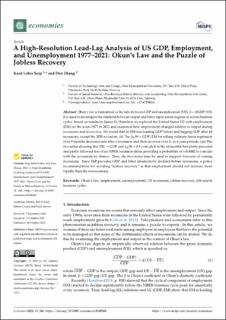| dc.contributor.author | Seip, Knut Lehre | |
| dc.contributor.author | Zhang, Dan | |
| dc.date.accessioned | 2023-03-06T13:15:06Z | |
| dc.date.available | 2023-03-06T13:15:06Z | |
| dc.date.created | 2022-10-20T17:43:01Z | |
| dc.date.issued | 2022 | |
| dc.identifier.citation | Economies. 2022, 10 . | en_US |
| dc.identifier.issn | 2227-7099 | |
| dc.identifier.uri | https://hdl.handle.net/11250/3056087 | |
| dc.description.abstract | Okun’s law is formulated as the ratio between GDP and unemployment (UE): β = f(GDP/UE). It is used to investigate the relations between output and labor input across regions or across business cycles. Based on results by James D. Hamilton we replaced the United States UE with employment (EM) for the years 1977 to 2021 and examined how employment changed relative to output during recessions and recoveries. We found that (i) EM was leading GDP before and lagging GDP after all recessions, except the 2020 recession. (ii) The βE(9) = GDP/EM for rolling ordinary linear regression over 9 months decreases just after a recession and then recovers over 2- to 4-year periods. (iii) The two series showing that EM → GDP and βE(9) < 0.5 coincided in the 34 months that partly preceded and partly followed five of six NBER recession dates, providing a probability of ≈0.0002 to coincide with the recessions by chance. Thus, the two series may be used to support forecasts of coming recessions. Since EM precedes GDP and labor productivity declines before recessions, a policy recommendation for avoiding “jobless recovery” is that employment should not increase more rapidly than the real economy | en_US |
| dc.language.iso | eng | en_US |
| dc.publisher | MDPI | en_US |
| dc.relation.ispartofseries | Economies;Volume 10 / Issue 10 | |
| dc.rights | Navngivelse 4.0 Internasjonal | * |
| dc.rights.uri | http://creativecommons.org/licenses/by/4.0/deed.no | * |
| dc.title | A High-Resolution Lead-Lag Analysis of US GDP, Employment, and Unemployment 1977–2021: Okun’s Law and the Puzzle of Jobless Recovery | en_US |
| dc.type | Peer reviewed | en_US |
| dc.type | Journal article | en_US |
| dc.description.version | publishedVersion | en_US |
| dc.rights.holder | © 2022 by the authors | en_US |
| dc.source.articlenumber | 260 | en_US |
| cristin.ispublished | true | |
| cristin.fulltext | original | |
| cristin.qualitycode | 1 | |
| dc.identifier.doi | https://doi.org/10.3390/economies10100260 | |
| dc.identifier.cristin | 2063389 | |
| dc.source.journal | Economies | en_US |
| dc.source.volume | 10 | en_US |
| dc.source.issue | 10 | en_US |
| dc.source.pagenumber | 1-16 | en_US |

